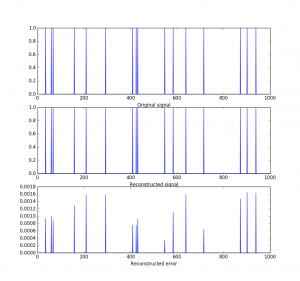Minimal Compressive Sensing example
During my master thesis is was working on Compressive Sensing algorithms. Compressive Sensing (or Compressed Sampling) is about reconstructing a signal from fewer samples than the signal actually has. This only works when the signal is sparse in some domain.
Now I want to get back into the topic and for this reason I wrote the smallest example for Compressive Sensing that came to my mind. A random sequence of sparse spikes is generated and then I reconstruct the sequence with fewer samples than the original sequence. The signal is sampled by using a normal distributed sampling matrix and the implementation uses the Lasso function of scikit learn.
In the following plot you can see the reconstruction of a signal of length 1000 with only 200 samples. An undersampling factor of 200
 And here is the short script written in Python
And here is the short script written in Python
import numpy as np
from sklearn import linear_model
import matplotlib.pyplot as plt
n=1000
m=200
percent_zero=0.98
signal = 1.0*(np.random.rand(1, n) > percent_zero)
sampling_scheme = 1.0*(np.random.randn(m, n))
samples = np.dot(sampling_scheme, signal.T)
clf = linear_model.Lasso(alpha=0.001, fit_intercept=False, positive=True)
clf.fit(sampling_scheme, samples)
print("Non zeros original signal: %i" % sum(signal.T > 0))
print("Non zeros reconstructed signal: %i" % sum(clf.coef_ > 0))
plt.subplot(311)
plt.plot(signal.T)
plt.xlabel("Original signal")
plt.subplot(312)
plt.plot(clf.coef_)
plt.xlabel("Reconstructed signal")
plt.subplot(313)
plt.plot((signal-clf.coef_).T)
plt.xlabel("Reconstructed error")
print("Reconstrudtion RMSE: %f" % np.sqrt(np.mean(delta * delta)))
Code is also available on GitHub
Also check out my second post about compressive sensing.